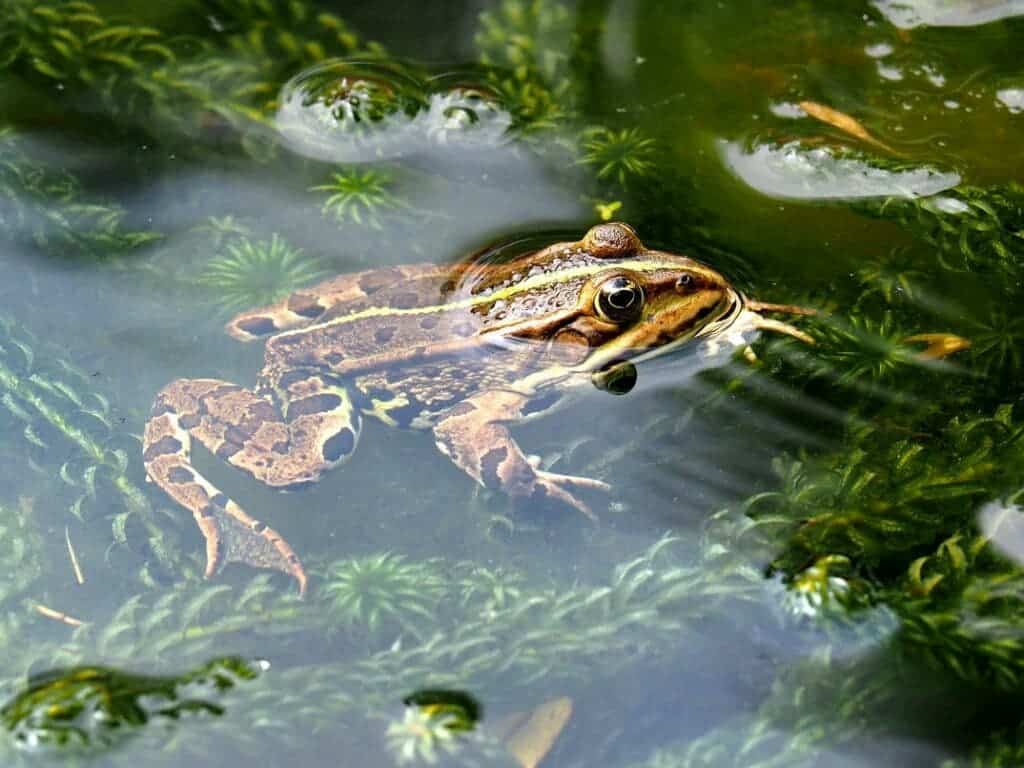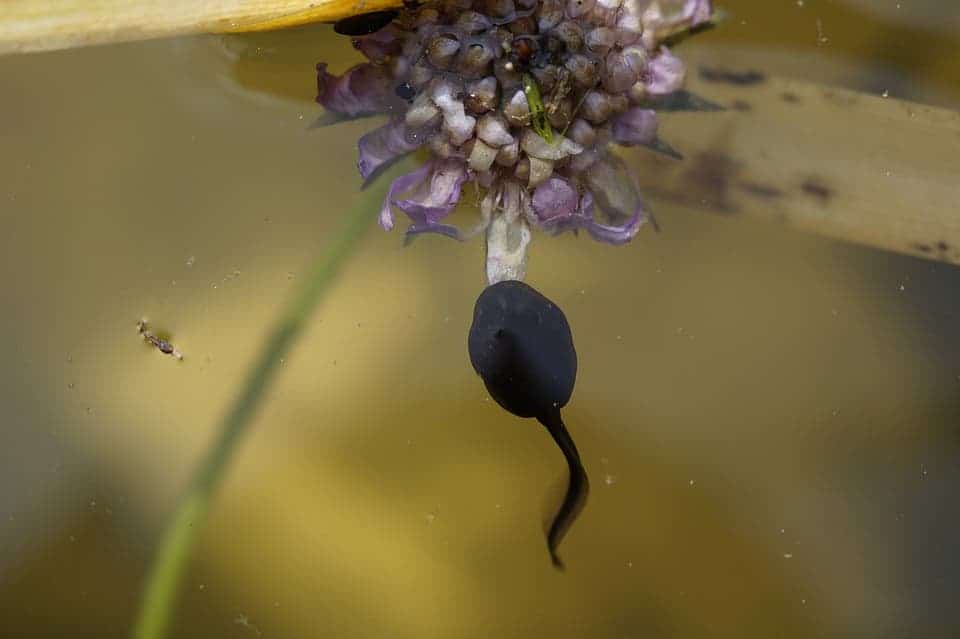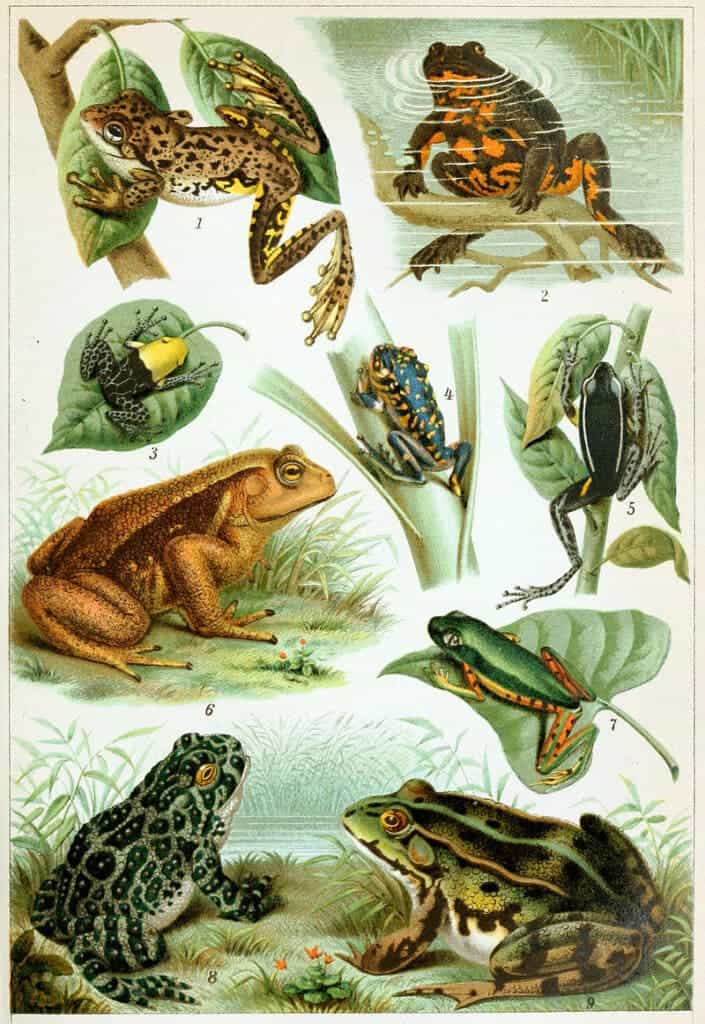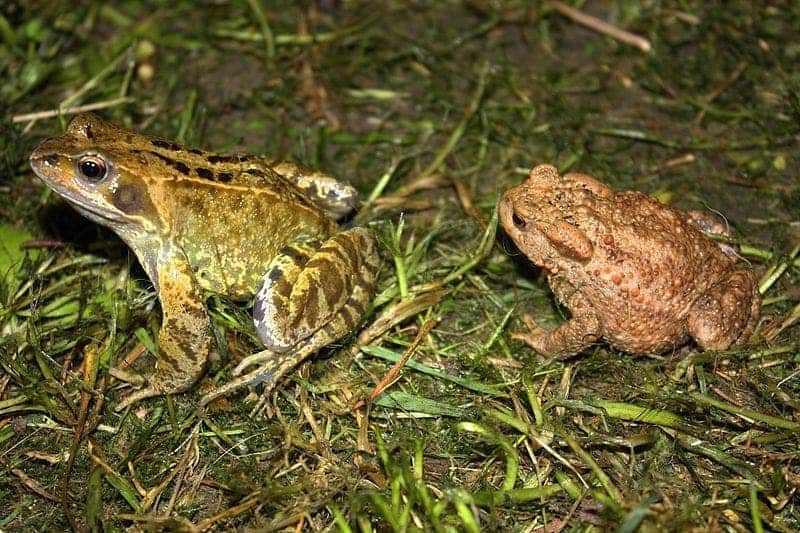Frogs are by far the most widespread amphibians — they make up almost 90% of all the current amphibian species. Frogs generally spend their time around bodies of freshwater, in areas that remain wet even during the summer. So, naturally, this influences their eating patterns.
Adult individuals of almost all species are carnivorous, most often preying on invertebrates such as worms, snails, slugs, and arthropods. It’s sometimes said that frogs are “insectivores”, but that’s not technically true. They’re often generalist carnivores, eating pretty much anything they can swallow. Sometimes, they will hunt reptiles, amphibians, even small mammals. They sometimes even engage in cannibalism, while some species mostly feed on plants.
When it comes to what frogs eat, the answer is both simple and complicated.

What frogs eat — the tadpole edition
Frogs typically have five life stages. They start out as eggs and then become tadpoles, tadpoles with legs, young frogs, and adult frogs. During their tadpole stage, they’re extremely different from their adult stage. Tadpoles generally lack limbs and have a tail, they breathe through gills and live exclusively in water. The metamorphosis from tadpole to frog involves some major biological changes, including a change in diet.
The diet of tadpoles is also different from that of adults. Tadpoles are typically herbivorous and their preferred food is algae. They also scrape leaves from the pond, if available. If you want to feed tadpoles (though you shouldn’t start randomly feeding tadpoles in the wild), greens are probably your best options. Lettuce, broccoli, baby spinach all work great.
However, tadpoles aren’t exactly picky. Most species are carnivorous at the tadpole stage, but in a pinch, almost all tadpoles would eat insects, mosquito larvae, smaller tadpoles, or even carcasses. In fact, several species have been found to be cannibalistic at the tadpole stage, and tadpoles that develop legs early are more likely to be eaten, so late bloomers are more likely to survive.
It’s a tough life for a tadpole, and being picky with food is a luxury you can’t really afford.

Adult frogs and what they eat
Frogs don’t really roam much; they tend to stick close to the water that is so crucial to them. Although some species can travel for several kilometers, it’s common for frogs to stay within a few hundred meters (usually less than 500 meters) around their pond area. As a result, they have to eat things that they can reliably catch around their area.
This being said, frogs will often eat any living thing they can fit into their mouths. If it flies, walks, or crawls and it’s not too big, frogs will often have a go at it. Aside from the common prey (bugs, worms, snails, slugs), they will eat smaller mammals, reptiles, fish, or even small marsupials. The list isn’t limited to only these. Frogs are true generalist predators, and anything small enough to be eaten by a frog could be eaten by a frog. Moths, butterflies, crickets, even bees — all could be found on frogs’ menus.
Frogs hunt by using their specialized tongue and spit. Frog spit is one of the stickiest substances on the planet, and frogs’ tongues can extend out at a whopping 4 meters per second, and can be retracted in 0.07 seconds — five times faster than you can blink.
Generally, frogs like to hunt. They don’t really like carrion or leftovers from other animals (though on very rare occasions, they might also eat it). When they eat things like slugs or other mollusks, they generally swallow the shell whole. They don’t really pay much attention, and if they’re hungry and they can snag something, they’ll generally go for it.

This being said, a few species also eat plant matter; for instance, the tree frog Xenohyla truncata is partly herbivorous, and its diet includes a large proportion of fruit. Several other species of frogs have been found to consume significant quantities of plants, and the diet of Euphlyctis hexadactylus consists of 80% leaves and flowers (though its juveniles are insectivores.
During the winter, frogs hibernate, slowing their metabolism and surviving until spring from the food they’ve consumed. Some species dig a burrow for themselves, others bury themselves in leaves, while some merely sink to the bottom of the pond, half-covered in mud. During hibernation, they obviously don’t eat anything. Fun fact: some frogs can indeed freeze and survive frozen for months, coming back to life when they thaw.
What does the common frog eat
There are over 5,000 species of frogs, making up around 88% of all amphibian species on Earth, and researchers are constantly finding new species as well. Here, we’ve tried to address the question of what frogs eat generally, but let’s take a moment to talk about the common frog.
The common frog (Rana temporaria), true to its name, can be found across most of Europe, including Scandinavia, Ireland, and the Balkans. It can also be found across vast swaths from Asia, up to Japan. By and large, it’s the most common frog species out there.
The common frog’s eating patterns are greatly influenced by the time of year, and like many other frogs, they also enter a type of hibernation. When they are active, they mostly eat invertebrates: snails, worms, wood lice, and spiders. They have a keen sense of smell and can detect worms or other prey of interest. They also eat larvae from other common frogs.
What about toads, what do toads eat?
Although the difference between toads and frogs seems significant, and you occasionally come across someone who’s quick to point that out, the use of the name toads and frogs has no taxonomic justification. It’s more of an esthetic consideration. ‘Frog’ usually refers to species that are either fully aquatic or semi-aquatic and have moise, smooth skins, while toads are terrestrial and have dry, warty skins (although there are exceptions).

As a result, because toads and frogs are so similar, they eat kind of the same thing. Toads mainly eat insects and other arthropods. They often enjoy eating things like worms and crickets. Sometimes, toads will also hunt prey like small mammals or even other amphibians.
Notably, frogs and toads are useful as they can keep the insect population under control. But they can also cause substantial damage, and several species of frogs and toads are invasive. A notable example dates from 1935 when cane toads from Puerto Rico were brought to Australia to control the sugarcane beetle population. The idea backfired spectacularly. Out of 102 toads that were introduced, their numbers grew to over 2 billion. They killed the beetles alright, but they killed a ton of native species as well and have become a major environmental problem.
At the end of the day, there’s a bunch of different frogs out there, with different eating patterns. Generally, frogs are indiscriminate predators, but some have more varied preferences. Undoubtedly, there’s still a lot left to learn about species of frogs, especially species from remote areas.
Frogs are also faced with a number of environmental threats; the common frog may be common, but other species are under a great deal of pressure. Out of the around 5,000 species of frogs we know, 737 species are endangered and 549 are critically endangered, and over 100 have probably gone extinct in recent times already (that we know of — the reality is quite possibly even worse). Among the biggest environmental threats, frogs are faced with are habitat destruction and other invasive species.
What do frogs eat — and other froggy facts you never wanted to know - ZME Science
Read More

No comments:
Post a Comment